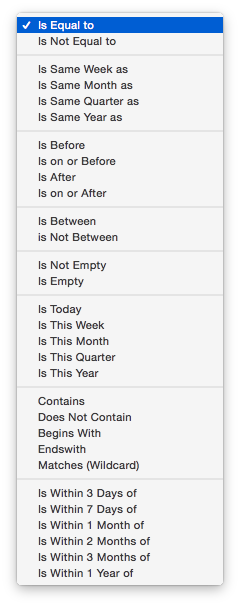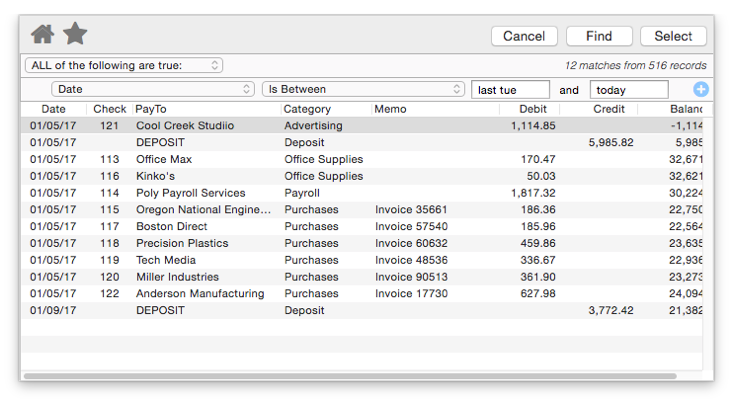When searching in a date field there are over two dozen options for determining whether data is a match.

When specifying a date you can use Smart Dates, so you can use dates like March 12, yesterday, or last tuesday as well as more conventional dates like 3/12/18.
Is Equal to (=) — Any data cell that exactly matches the match value will be identified as a match.
Is Not Equal to (≠) — Any data cell that does not exactly match the match value will be identified as a match.
Is Before — Any data cell that contains a date before the date you type into the box on the right will be identified as a match.
Is on or Before — Any data cell that contains a date before or on the date you type into the box on the right will be identified as a match.
Is After — Any data cell that contains a date after the date you type into the box on the right will be identified as a match.
Is on or After — Any data cell that contains a date after or on the date you type into the box on the right will be identified as a match.
Is Between — Any data cell that contains a date between the two specified dates will be identified as a match. In this example all checks between last tuesday and today are selected (the example was taken on January 9, 2017).

Is Not Between — Any data cell that contains a value outside the two specified dates will be identified as a match.
Is Not Empty — Any data cell that contains any date will be identified as a match. Blank cells will not be selected.
Is Empty — Any data cell that does not contain a value will be identified as a match. In other words, this option locates completely blank fields.
Is Today — Any data cell with today’s date is identified as a match.
Is This Week — Any data cell in the current week is identified as a match.
Is This Month — Any data cell in the current month is identified as a match.
Is This Quarter — Any data cell in the current quarter (3 months) is identified as a match.
Is This Year — Any data cell in the current year is identified as a match.
Is Within 3 Days of — Any data cell that contains a date within 3 days of the specified date will be identified as a match.
Is Within 7 Days of — Any data cell that contains a date within a week of the specified date will be identified as a match.
Is Within 1 Month of — Any data cell that contains a date within a month of the specified date will be identified as a match. (The exact comparison is any date within 31 days before or after the specified date.)
See Also
- age( -- calculates a person's current age (in years) from their birthdate.
- checkemptyselection -- notifies the user if a selection failed, and reverts to the previous selection.
- completedatestr( -- converts a date to text, spelling out the month and including the day of the week.
- Date Arithmetic Formulas -- performing calculations on dates, and converting between dates and text.
- Dates -- working with dates.
- datestr( -- converts a date to text using format *mm/dd/yy*.
- daystr( -- converts a date to the day of the week (for example *Sunday*).
- eurodatestr( -- converts a date to text in European format.
- Favorite Searches -- saving and recalling favorite searches.
- find -- locates the first visible record in the active database for which the specified condition is true.
- Find & Replace Dialog -- finding and replacing a word or phrase (with an option to use a regular expression).
- Find/Select Dialog -- using a dialog to search for specific data.
- findabove -- locates the next previous record (above the current record) in the active database for which the specified condition is true.
- findbackwards -- locates the last visible record in the active database for which the specified condition is true.
- findbelow -- locates the next visible record (below the current record) in the active database for which the specified condition is true.
- findid -- locates a record in the active database by its ID number (see info("serverrecordid").
- findnth -- finds the nth (2nd, 3rd, 4th, etc.) record that matches a true-false test.
- findselect -- opens the standard *Find/Select* dialog.
- findselectdialog -- opens the standard *Find/Select* dialog.
- Formula Search -- searching with a formula.
- Handling Empty Selections in Code -- dealing with an empty selection data set.
- ifselect -- combines the select and if info("empty") operations into a single statement.
- info("empty") -- returns true or false depending on the result of the last select operation. If no records were selected the function will return true, otherwise it will return false.
- info("found") -- returns true or false depending on whether the last *find* or *next* statement was successful.
- info("selectduplicatesortwarning") -- works with the selectduplicatesnowarning statement to ascertain whether or not the database was sorted correctly when last search for duplicates was performed.
- longdatestr( -- converts a date to text by spelling out the month.
- nextmatch -- locates the next visible record in the active database for which the condition specified in the most recent Find statement is true.
- Numeric Search Options -- searching numbers within a database.
- pleaseselectall -- makes sure that all records are selected.
- previousmatch -- locates the previous (closer to the top) visible record in the active database for which the condition specified in the most recent Find statement is true.
- Record Search Options -- searching via record attributes.
- Refining a Selection -- selecting a subset or superset of a previous selection."
- removeselected -- deletes all selected records from the database.
- removeunselected -- deletes all unselected records from the database.
- safeselect -- makes visible only those records for the active database for which the specified condition is true. If no records match, the previous selection is retained.
- safeselectwithin -- makes visible only those previously selected records in the active database for which the specified condition is true. If no records match, the previous selection is retained.
- search( -- searches through an item of text looking for a character, word or phrase. If it finds an exact match (including upper/lower case) with the character, word or phrase, it returns its position within the text item. If it does not find the character, word or phrase, it returns zero.
- searchanycase( -- searches through an item of text looking for a character, word or phrase. If it finds a match (upper/lower case may be different) with the character, word or phrase, it returns its position within the text item. If it does not find the character, word or phrase, it returns zero.
- Searching -- searching a database to find or select information.
- select -- makes visible only those records for the active database for which the specified condition is true.
- Select Duplicates Dialog -- opens the standard *Select Duplicates* dialog sheet.
- selectadditional -- adds unselected records to a previously selected group if they match the true-false test.
- selectall -- makes every record in the database visible.
- selectduplicates -- selects records containing duplicate information in the database.
- selectduplicatesnowarning -- selects records containing duplicate information in the database.
- Selecting with the Context Menu -- searching for information related to the current cell.
- selectreverse -- makes every visible record invisible, and every invisible record visible.
- selectwithin -- uses a Boolean formula to exclude records from a previously selected group.
- Smart Dates -- keyboard entry of dates.
- Text Search Options -- searching text within a database.
- years( -- converts a number of days into a number of years.
- yearsbetween( -- calculates the number of years between two dates.
History
| Version | Status | Notes |
| 10.0 | No Change | Carried over from Panorama 6.0 |